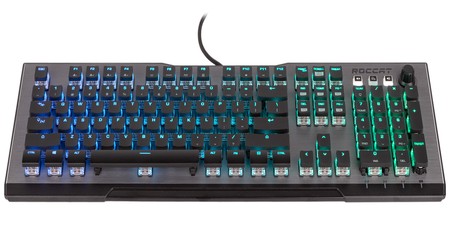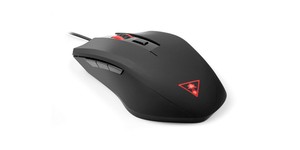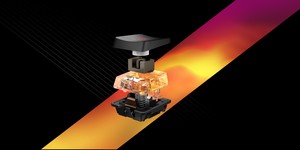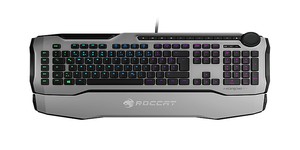
Manufacturer: Roccat
UK price (as reviewed): MSRP £149.99 (inc. VAT)
US price (as reviewed): MSRP $159.99 (exc. tax)
We’re sweating it up in Taipei, risking earthquakes and suffering mosquito bites to bring you the latest hardware coverage from all your favourite brands at Computex 2018. One such brand is peripherals specialist Roccat, which has used the opportunity to launch a brand new family of keyboards that marks a new step in terms of design and aesthetic. We received the Vulcan 120 Aimo a few weeks prior to the show, so today we can bring you the full review. Note that ours is a US layout model, but localised ones will of course be available when the keyboard launches, which isn’t actually until late Q3.

Last week, Roccat revealed its new Titan Switch Tactile, a mechanical switch designed entirely in-house at Roccat and manufactured in partnership with TTC, and the Vulcan 120 Aimo is the new flagship keyboard that makes use of it. Also launching are the £140 Vulcan 100 Aimo (same as this with no wrist rest) and the £120 Vulcan 80 (single-colour lighting, no dedicated media contols). As the name suggests, this keyboard utilises Roccat’s Aimo RGB lighting system, which aims to bring intelligence to RGB configurations and give you pleasant effects that adapt to what you’re doing without you having to configure anything manually. We first saw it with the Kone Aimo mouse, but a keyboard obviously has much more lighting, so we were eager to see what it’s like.

First, though, the keyboard itself. The Vulcan 120 has a striking design and one that’s different to previous Roccat models. We rather like it, but of course your mileage may vary. The keycaps are both raised and very shallow, meaning that you get a great view of the switches beneath – it’s rather typewriter-esque. A grey brushed aluminium faceplate adds some sophistication and keeps the keyboard feeling rigid. The plastic underside, meanwhile, is appropriately adorned with rubber to keep grip levels up. The braided cable is non-detachable, and the Vulcan 120 doesn’t offer any pass-through ports.

The wrist rest has a smooth, matt plastic surface and is decently sized. It attaches to the front lip of the keyboard magnetically, and the force of the connection is fit for purpose. It also has plenty of rubber of its own to keep it in place.

The Titan switches offer tactile, non-clicky feedback with an actuation point of 1.8mm which is halfway through the 3.6mm total travel – 10 percent less than Cherry MX Brown switches on both fronts. The actuation force is 45g, which matches the Cherry MX equivalent. The cross-shaped, military green plunger technically makes them compatible with aftermarket keycaps designed for Cherry MX switches too, but we've been told it's not actually designed for this and non-standard sized keycaps may not play nice. There’s extra stability on these switches as well thanks to additional plastic that completely seals the receiving part of the keycap. The housing is clear, exposing the innards nicely and also ensuring that as much light as possible from the surface-mounted RGB LED is visible. Roccat also claims to have achieved a 20 percent lower switch bounce time (rated at 4ms) than traditional switches, further boosting responsiveness.
Typing on the Vulcan 120 for the first time, I was very impressed. It feels very natural, and there was nothing I needed to adjust to. The switches are a pleasure to type on, likewise with gaming, but I can’t say honestly that it felt any faster than I was used to from various other mechanical keyboards. I never experienced any problems with missed key presses or anything that would suggest the switches aren’t up to scratch either. That said, if you deliberately push a key very slowly, it is possible to feel the bump without actually actuating the switch, which I’ve never been able to replicate on a Cherry MX switch. In theory, then, a missed press is possible, but it’s highly unlikely when actually typing or using the keyboard in any normal way, as the force you use will be enough to reach the actuation point.

In the top right are some dedicated custom keys. You have an audio mute button, and then a plastic wheel which controls volume or backlight brightness; you toggle which it does using the two buttons next to it. The wheel itself has a satisfying action with tactile notches, but it would be great if it were made from metal instead. The spongy buttons, meanwhile, are a disappointment in so premium a keyboard. Their lighting is also white only, not RGB. With these buttons here, the lock indicators have been moved to the bottom right.

An FN key unlocks extra functions on some of the keys. For example, keys F1-F4 allow you to switch between the onboard profiles (five supported in total), while others are used for Windows shortcuts and media functions. Within each profile, you can trigger a Game Mode, which disables the Windows key and unlocks further functions for each key. In this mode, you can assign macros and other custom functions to most keys, and the Caps Lock button becomes the Easy-Shift+ key, unlocking even more custom commands for some of the keys in the same way that a traditional Shift key does. However, to make use of these extras, you’ll need to download and install the Swarm software.

MSI MPG Velox 100R Chassis Review
October 14 2021 | 15:04








Want to comment? Please log in.